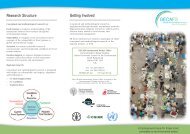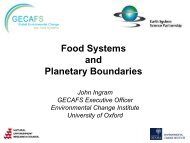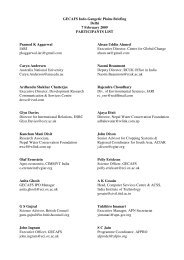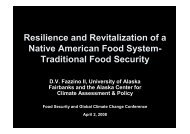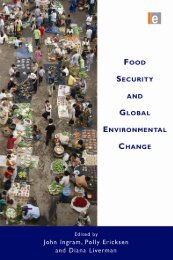From Food Production to Food Security - Global Environmental ...
From Food Production to Food Security - Global Environmental ...
From Food Production to Food Security - Global Environmental ...
- No tags were found...
You also want an ePaper? Increase the reach of your titles
YUMPU automatically turns print PDFs into web optimized ePapers that Google loves.
contribution <strong>to</strong> the science agenda: it helps understanding of how food systems actuallyoperate by identifying the many and complex cross-scale and cross-level interactions theyencompass. It also helps understand why actions and interventions aimed at improving foodsecurity can fail due <strong>to</strong> situations in which the current combination of cross-scale and crosslevelinteractions threatens <strong>to</strong> undermine food security in three situations: Ignorance,Mismatch and Plurality.In addition <strong>to</strong> underscoring the need for contributions from a range of disciplines, the foodsystems approach engenders a greatly enhanced discussion on food security. It frames thefood system activities as dynamic and interacting processes embedded in social, political,economic, his<strong>to</strong>rical and environmental contexts; it relates the food system activities (the“what we do”) <strong>to</strong> the outcomes of these activities (the “what we get”) not only for foodsecurity and other socioeconomic issues, but also on the environment; and it helps frameadaptation discussions by identifying which aspects of the food system are vulnerable <strong>to</strong> whatstresses. Finally, the approach enhances the science agenda by explicitly considering feedbacks<strong>to</strong> both environmental and socioeconomic conditions for given adaptation options. Thishas great policy relevance as the intended consequences (the ‘impact’), and (often moreimportantly) the unintended consequences of a given technical or policy intervention need <strong>to</strong>be carefully assessed.The notion of ‘food system ecology’ is developed by drawing on lessons from productionecology, agroecology and human ecology. The interest in gaining a more mechanisticunderstanding of food production (and crop growth in particular) led <strong>to</strong> the development of‘production ecology’ and the broader concept of ‘agroecology’. The former is oriented<strong>to</strong>wards optimization of agroecosystems <strong>to</strong> fulfil production aims based on using bestecological insights, and a number of crop, crop-soil and crop-soil-pest modelling approacheshave been developed relating <strong>to</strong> a range of production situations, i.e. potential, water and/ornutrient-limited.. The latter, incorporating both agroecosystems and other ecosystems atlandscape level, has multiple aims including other ecosystem ‘goods and services’.Interdisciplinarity and scaling across spatial levels are central tenets in both approaches, andthe broad agroecology concept thereby helps move the debate <strong>to</strong>wards the broader foodsecurity agenda.While the production ecology and agroecology concepts have therefore moved well beyondfood production at local level <strong>to</strong>wards food availability at higher levels neither, however,addresses the broader issues underpinning food security. For instance, affordability, foodallocation and cultural norms, food preferences and the social and cultural functions of food,and food safety, all need <strong>to</strong> be fac<strong>to</strong>red in. This needs additional analyses of the consequencesof human activities as a chain of effects through the ecosystem and human social system.This is the realm of human ecology, concepts from which are very relevant for food systemsanalyses, given the importance of the linkages between the wide range of ac<strong>to</strong>rs involved andthe outcomes of their varied activities. This is because food systems strongly involve –indeed depend on – relations and interactions between ac<strong>to</strong>rs and their environment. They (i)embody key interactions within the biophysical sphere, the socioeconomic sphere, and the142



